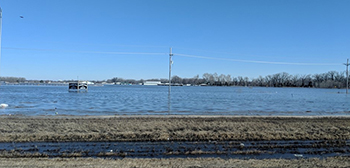Midwest Floods, Trade Negotiations Affect Alabama Planting Intentions

Debra Davis
(334) 613-4686
Historic flooding in America’s Corn Belt and international trade negotiations are altering planting intentions of some Alabama farmers.
The U.S. Department of Agriculture (USDA) issued its annual prospective planting report March 29 when many farms from the Dakotas to Missouri were still under water. The floods came just before planting season started in the Midwest and are expected to reduce corn, wheat and soybean acreage. Millions of bushels of stored grain and soybeans also were damaged by Midwest floods.
“I expect none of those flooded acres were considered in USDA’s report,” said Macon County Farmers Federation President Shep Morris. “That would make a significant difference of what could be planted there. It will take some time to get those flooded acres back in production and to repair infrastructure. That lost acreage would provide an opportunity for farmers here.”
Nearly 1.1 million acres of cropland and more than 84,000 acres of pastureland in the Midwest experienced flooding at least seven days between March 8 and March 21, according to preliminary analysis of government and satellite data.
Even when waters recede, silt, mud and debris could make planting difficult. Midwest farmers also are facing crop insurance planting deadlines. For example, Iowa farmers must plant corn by May 31 and soybeans by June 15.
Morris said Alabama’s poultry industry uses 4-5 million acres of Midwestern corn annually. Most of that corn is shipped by rail from Midwest storage facilities.
“Rail systems in some flooded areas were devastated, as were countless roads and bridges,” Morris said. “No one really knows how long it will take to repair that infrastructure.”
USDA’s report predicts U.S. farmers will plant 92.8 million acres of corn, a 4% increase over last year.
In Alabama, the report predicts farmers will plant 280,000 acres of corn, an increase of 20,000 acres over 2018. However, some Alabama farmers think the report could be off by several thousand acres.
“I think you’ll see more farmers plant corn in our state than the report predicts,” said Morris, who’ll plant 1,300 acres of corn in Macon and Montgomery counties, 400 acres more than last year. “The market price for corn might not be all that good (September futures have corn at $3.80 per bushel), but our local markets for the poultry industry are strong.”
Morris said his state’s corn growers have an advantage over Midwestern farmers because Alabama-grown corn doesn’t have additional transportation costs.
In Pickens County, Annie Dee said her farm is flipping acres from soybeans to corn.
“Typically, we have 4,000 acres of row crops — 2,400 acres of soybeans and 1,600 acres of corn,” said Dee, who farms with brother Mike Dee and her sons, Seth and Jesse More. “This year, we’re planting 400 acres of soybeans and 3,600 acres of corn.”
Dee said she thinks more U.S. farmers will switch from soybeans to corn because of tariffs imposed by China and other countries. Corn, she said, has a steady market in the U.S. — especially in Alabama, which is second in the nation in broiler production.
“I also think farmers may see an opportunity for more local corn because of the floods in the Midwest,” she said.
Whether it’s global markets or poor domestic demand, USDA’s report says soybeans will dip to 84.6 million acres, down 5% from last year.
The expected drop in Alabama soybean acres exceeds national predictions. USDA estimates 280,000 acres will be planted — down 65,000 acres from last year, a 19% drop.
“A lot of farmers had a tough time with soybeans last fall,” Morris said. “Persistent rain made harvest difficult or impossible. I heard reports of some farmers who had soybeans that rotted in the field. Add in a suppressed market price, and the result is fewer acres planted this year.”
Cotton is expected to remain Alabama’s largest row crop, with farmers planning to plant 510,000 acres — about the same as last year. Nationally, cotton acreage is predicted to rise about 2% to 13.8 million acres.
Alabama peanut farmers are expected to plant 170,000 acres, a 3% jump from 2018. Nationally, peanut acreage is expected to rise 2%, topping out at 1.4 million acres, according to the USDA report.
While Alabama isn’t a major player in the U.S. wheat market, planting that took place here last fall is up 6% from the previous year, and farmers are expected to harvest 170,000 acres. However, U.S. wheat acreage is predicted to be down 4%. The 45.8 million acres represents the lowest wheat acreage since records began in 1919, according to USDA.
